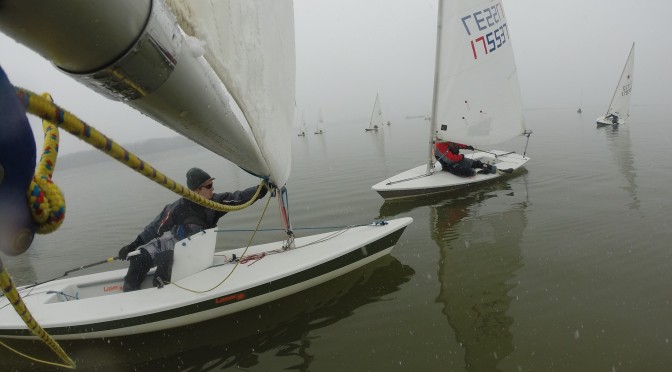This past Sunday we had really nice weather conditions, warm steady (light) breeze coming from the south and nice crystal clear blue Potomac water with occasional small ice chunks just to remind us that we’re still frostbiting.
Thanks to RC Nick Allen and Cliff Bartlett for getting in a lot of races within the allotted time period. Also, it seemed the shorter course with three laps was popular, as it gave us some exciting mark roundings. Thanks also to Fleet Captain Eric Peterson for helping us to build one of the biggest fleets I have ever seen. 24+ boats on typical day is really impressive.
So again I’d like to make this write up a bit more for the beginner. Nine years ago when I started with Lasers in PRSA frostbite, I was not only last in most races, but also so far behind that I had to remind the RC not to hold up the next race waiting on me. So if you are new to this fleet and a little behind, just hang in there and have fun sailing, and time in the boat will improve your scores.
Here are some basic pointers:
Sail settings: On Sunday I had my vang on about 1/3, cunningham off except maybe upwind, then I had it slightly on. Outhaul was set so the draft of the sail was about 3” from boom. Note, if you seem to be doing well, don’t change your sail settings. If you feel slow, just go ahead and experiment and make changes to your sail settings.
Starts: On Sunday I was coming in on port and looking for holes in the line, and then tacking over to starboard at the last instant. Sometimes this works, sometimes not. It’s a little risky. Again, for beginners, start on a safe starboard tack, and try to get yourself up on the line and get used to being in the first row of boats. So long as you are on starboard tack and heading up if someone to your leeward hails you to come up, there is not much that can go wrong (except that you are over early). This is just something you need to get comfortable with. Good starts will then come in time.
Roll Tacks: I am probably not roll taking correctly, but I do know that when you come out of a roll tack, you should feel the boat sort of accelerate at the end. If you do not, then there is a problem, because that is going to affect your performance very much. Talk to me off line if you have questions. Erich Hesse who used to sail with us, commented once on my tacking and showed me what I was doing wrong, and sometimes being shown one-on-one will really help you. So don’t be afraid to ask someone to look at your tacking and give you their feedback. I am out a lot on Wed nights in the summer and also I’m usually out early before the starts on the frostbite Sundays.
Preparing to round the windward mark: If you can, take a moment to try to ‘clear the sheet’ (as Len taught me), that is get any tangles out of the mainsheet now so that when you go around the windward mark you don’t get stuck untangling your line.
Rounding the windward mark: When you round the windward mark, try not to let your mainsheet out all the way right away. Instead, let it out slowly so that the sail stays powered up as you begin the downwind leg. If you let it out all the way, right away, then you may be losing a little speed as your sail temporarily luffs.
Downwind Leg: When the air is light and steady like it was on Sunday, try to heel your boat to windward a bit and sit forward near the centerboard. As you are heeling the boat to windward, hold on to the top of the centerboard, and use your shoulder muscles to maintain the proper heel angle. This means you will feel your arm and shoulder getting a good workout, because as the boat heels too much or too little, your corrections are going to be made by your arm pulling on the centerboard, and your adjustments are going to be very slight and very smooth. All this will add up to you feeling your arm and shoulder getting a Nautilus style workout like at the gym, even when the air is light. When the air is heavy, you probably won’t be doing this, but rather hanging on for dear life like I do and trying to prevent a death roll.
Jim Klein

